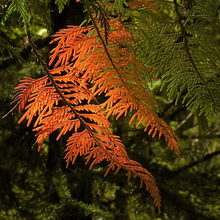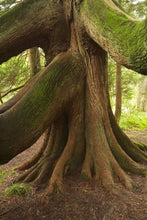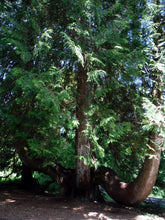Thuja plicata
For thousands of years, western red cedar has been known as the tree of life and has been used extensively by humans and wildlife. It is a large, aromatic, evergreen tree with elegantly swooping branches and a pyramidal shape; wide and fluted at the base and tapering to the tip. Its iconic gray to reddish-brown bark is thick, fibrous and peels easily. The attractive, weeping branchlets are scale-like leaves pressed tightly into flat, lacy sprays. Small male and female cones grow on separate branches in April and May, in loose clusters turned upward. The males are small, numerous, and cylindrical. Females are longer, stubbier, and woody-brown in color. They mature in August and disperse seeds in the fall.
- Plant type/canopy layer: evergreen perennial large tree
- Size at maturity: 100’ - 230' tall; trunk diameter grows incrementally larger over many decades; elder giants, found in old growth areas such as the coastal rainforests of the Olympic Peninsula and Vancouver Island, can be 20’ - 30' wide and 1400 years old
- Light requirements: mostly sunny to full shade
- Moisture requirements: moist to wet soil
- Bloom time: March - June (earlier in southern coastal areas; later at high elevations, interior and northern stands)
- Growth rate/ease: moderate growth rate, easy to grow (in the right conditions)
- Wildlife support: winged seeds may be eaten by siskins, grosbeaks, waxwings, sparrows, and nuthatches; foliage, twigs and saplings are a critical food source for deer and elk during the fall and winter; the fibrous bark is used as a nesting material for porcupines and native squirrels; cavities and branch crooks of mature trees are shelter and nesting sites for small mammals and birds; wood and bark provide resources for countless species of insects, fungi, rare ferns and lichen; old trucks and large cavities provide den sites and shelter to larger mammals such as bears; overall plant is a caterpillar host and larval food source for over 30 species of native moths and butterflies and provides cover and roosting sites for several bird species including warblers, juncos, and jays, s well as small mammals; mature stands of trees
- Native habitat/range: common in forest habitats on both sides of the Cascade crest and along the coast from southeast Alaska to northern California and east to Alberta, Idaho, and northwest Montana. Portland Plant List - yes.
- Special features & uses: evergreen; wildlife favorite; landscape uses include raingardens, woodland gardens, erosion control, windbreaks, screens and hedges; exceptional at managing stormwater through enviro-transpiration; unsurprisingly, the “tree of life” has extensive ethnobotanical uses:
- Indigenous people have been using the wood for shelters, tools, canoes, cradles, firewood and much more for tens of thousands of years. In these instances, the trees were rarely felled, but instead they used fallen logs or split off boards from standing trees. Broad, unshredded layers of bark can be used as dishes or to line cooking pits, while shredded bark makes an excellent and strong fiber, for skirts or woven into rope, nets, mats, etc. The stripped limbs can be soaked and twisted into remarkably strong ropes or for weaving baskets. Plant extracts are potent and deliciously fragrant and are used in soaps, perfumes, shoe polishes, and to repel pests.
- Medicinally, buds were traditionally chewed or boiled and gargled for sore lungs or toothaches.
- To this day, it has many industrial and commercial uses. The wood is highly resistant to rotting, making it exceptional in construction such as shingles, canoes and boats, fence posts and decking, furniture, wood pulp and chips. However, it is allergenic and workers are advised to limit exposure.
Gardening with Western Red Cedar: Sadly, this species is one that is being negatively impacted by climate change. This isn’t to say you shouldn’t plant it. It is an exceptional and critical habitat tree. Simply that, with extreme heat and drought worsening in the summer months, it is important to plant western red cedar in a location that stays moist year-round (i.e. in a riparian area, edge of a wetland, boggy areas). Also note, the more sun it receives, the more moisture it will need to survive the summer drought. That said, it tolerates any soil type or drainage, as long as it's moist - but its dreamist home is in loamy soil. Plant it singularly or in groves as a screen or windbreak. With effort, it can be pruned and trained to become a habitat hedge. That said, this is an extremely valuable tree to wildlife when given the space and time to come into its glory, with lower branches allowed to droop elegantly to the ground and arch back up again. If you must prune, do so in winter when wood boring insects are less active.
Photo Credit 1: "Western Redcedar" by nordique is licensed under CC BY 2.0
Photo Credit 2: "Thuja plicata" by itmpa is licensed under CC BY-SA 2.0
Photo Credit 3: "Thuja Plicata" by Care_SMC is licensed under CC BY-ND 2.0






